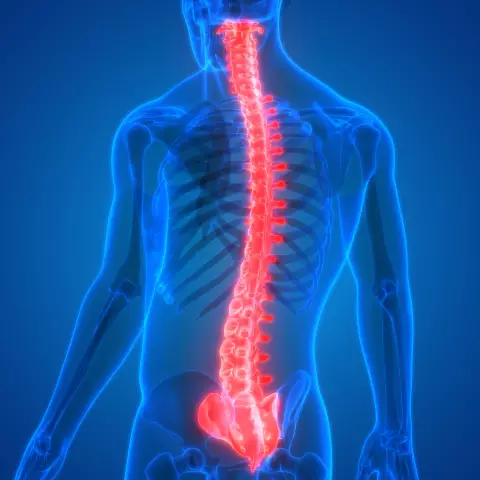- Author Rachel Wainwright [email protected].
- Public 2023-12-15 07:39.
- Last modified 2025-11-02 20:14.
Back muscles
The muscles of the back are quite numerous and are located in two layers - deep and superficial.

The superficial muscles of the back include the muscles attached to the girdle of the upper limb and shoulder, as well as to the ribs:
- trapezius muscle;
- the broadest muscle of the back;
- muscle lifting the scapula;
- large and small rhomboid muscles;
- Serrated muscles.
The deep muscles of the back lie in three layers: deep, middle and superficial. The deep layer is formed by the suboccipital, intertransverse and interspinous muscles. The middle layer is represented by the transverse spinous muscle. The outer layer is represented by the repair muscles of the neck and head, as well as the muscle that straightens the spine. The muscles in this layer are strong muscles and perform static work (maintain the correct vertical position of the spine).
Why do my back muscles hurt?
Almost every adult has at least once sought medical help with complaints that the back muscles hurt. The causes of these pains can be:
- Significant muscle load. It can be associated not only with performing hard physical work, playing sports. Long-term presence of a person in a forced position also exerts no less stress on the muscles of the back. Therefore, drivers or, for example, programmers often have back muscles hurting. To prevent static pain, you should take several short breaks during the working day, during which physical exercises are performed to strengthen the back muscles;
- Back muscle injuries (contusion, sprain) - most often occur when training back muscles, when too much load is immediately given to unprepared and unheated muscles;
- Myositis (muscle inflammation) is one of the most common causes of back pain. This disease usually has a long course. The nature of the pain is aching. Palpation (feeling) of the affected muscles reveals their compaction and soreness. In people suffering from metabolic diseases and some chronic infections, myositis can be combined with joint pain;
- Lumbago is the appearance of acute, burning pain in the lumbosacral region. The cause of development is most often the overstrain of the back muscles. A pain attack usually occurs when a weight is lifted or a sudden change in body position, for example, when trying to reach something. Lumbago can also occur when training the back muscles, when the physical activity is too high or the main stage of training begins without an appropriate warm-up of the back muscles;
- Radiculitis - occurs against the background of acquired or congenital changes in both the spine itself and its ligamentous apparatus (osteochondrosis, intervertebral hernia). Back pain is usually one-sided, it can be dull or acute, it increases with a change in body position, sneezing, coughing. Often it radiates to other parts of the body, and can also be combined with paresthesias (disorders of the sensitivity of the skin). excessive static load. However, in the acute period of the disease, training of the back muscles is contraindicated, and it can be started only after complete relief of the pain syndrome. Physiotherapy exercises, swimming are useful.
It is a well-known fact that often the back muscles also hurt in people who are often under stress or nervous strain. Stress leads to muscle spasm, which is what causes pain. In turn, this pain increases muscle spasm. The result is a vicious circle. In order to break it, pain relievers are not enough; in most cases, the doctor prescribes sedatives.
Found a mistake in the text? Select it and press Ctrl + Enter.






